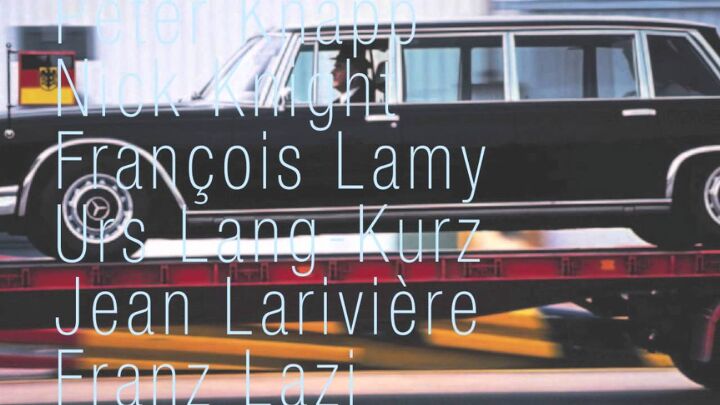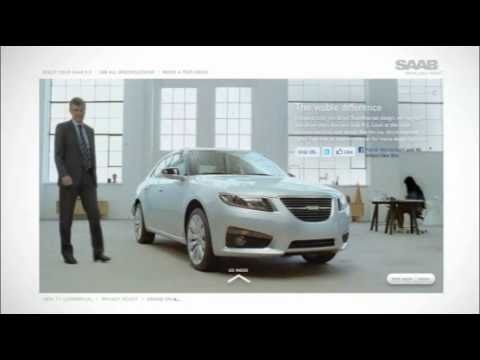#Advertising
Your Daily Driver: A Porsche
Porsche wants to do what every car maker wants. Sell more cars. So what would you do if you would have to move more Porsches? Tout their speed? Their horsepower? Call up Jack Baruth and offer him “Buy 10, get one free?” No, Siree. Porsche positions their cars as schoolbuses.
Consumer Like Those Electric Cars, They Just Don't Know Who Makes Them
Leaf or Volt? Ask the average person on the street that question, and you might get a response acknowledging that you’re talking about plug-in electric vehicles. Ask for more detail, and you may well be disappointed. Despite the many differences between the two vehicles, some simple and obvious, others subtle and complex, it’s unlikely that the average consumer is going to be able to tell you much about them. Why? Because chances are, your randomly-selected consumer doesn’t even know who makes which car. Automotive News [sub] reports that a Compete, Inc study shows
a little more than 17 percent of consumers polled knew that Nissan sells the Leaf. Another 13 percent incorrectly believed the car is offered by other brands, including Chevrolet and Toyota.
The Volt fared better. The study found that 45 percent of shoppers identified it as a Chevrolet.
Yowza. Considering that Nissan is betting bigger on EVs than any other manufacturer in the business, selling the only pure EV on the market and ramping up to 500k annual units of global battery production capacity, it needs to get on top of this branding awareness issue yesterday. Because as things stand, Nissan is making a gigantic global gamble only to find Chevrolet and Toyota stealing nearly as much credit for the Leaf as consumers give Nissan itself (13% versus 17%… what’s wrong with that picture?). Ads like this one are a good start, but Nissan needs to do more to ignore the Volt and make itself synonymous with pure-electric cars the way Toyota made itself synonymous with hybrids.
Truth Versus Advertising: The Dark Side Of The Force Edition
Every advertiser faces a basic choice at the outset of a campaign: come up with unique, relatable imagery for ads, or riff on an established cultural meme. Volkswagen went the latter route with its “Darth Vader” Super Bowl ad, achieving huge success: it was the most popular auto-related ad of the Super Bowl, and the Youtube version has received over 40 million views. The only problem with appropriating such popular imagery: you don’t enjoy unique rights to it, meaning you can be easily hoisted by your own petard. Which is exactly what’s happened here to Volkswagen. Greenpeace is angry that VW opposed a bid to bump the EU’s 2020 emissions goal from the agreed-upon 20% to 30% of 1990 levels (even though C02 emissions improved 3.7% last year and 5.1% in 2009, and average emissions are on track to hit the 130g/km 2015 goal ahead of schedule). As a result, they’ve turned VW’s hugely popular “Darth Vader” ad on its head, identifying the giant automaker with the evil Lord Vader, and encouraging fans to “join the rebellion.”
Chrysler Loses Court Battle Over "Imported From Detroit"
The Car's Courtesans: A Flashback At Car Photography
Jacques Séguéla, a French photographer and founder of the advertising agency RSCG supposedly once said: “Don’t tell my mother I’m in advertising, she thinks I’m a pianist in a brothel”. It must have been an exclusive brothel. Photographers, especially for cars, are paid higher and are sought after more than exquisite courtesans. Fees of $1,000 per hour are not unheard of. What do they do for that much money? They make the cars look good.
Ram Pickup Ads: Will "The Code Of The West" Revive Flagging Sales?
Having kept a relatively low profile since the disastrous “My Tank Is Full” series of ads, Ram is fighting to help keep Chrysler profitable with a new series of ads highlighting the Ram’s connection to “Wild West” values. And like nearly every bit of advertising approved by Chrysler Group ad boss Olivier Francois, it’s heavy on the hyper-sincere schlock, which makes the spots end up feeling like they’re selling a political candidate rather than a truck. And this just as it seemed like truck ads were slowly moving away from some of their previous cliches. Does doubling down on sincerity and the mythical Western ethos make sense as a way for Ram to catch back up on volume it’s lost over the last few years? Or should Ford’s stunning 50%-ish take rate on EcoBoost V6 engines in F-Series be pointing towards a more pragmatic, consumer-needs-oriented marketing campaign? Watch as many of the ads as you like and be sure to let us know where you see the Ram brand and its marketing effort heading.
Audi Imports Ad Idea From Detroit
Are Audi’s Mad Men missing Bertel’s services? They must be, as the Detroit Free Press reports that Eminem’s licensing firm has filed a motion in German court seeking to ban this advertisement. Joel Martin, manager of Eight Mile Style, tells the Freep that Audi did not license the Eminem song “Lose Yourself,” adding
It’s stunning. What makes it extraordinary is the similarity to the way Chrysler is using (the song). We saw it and said, “This has got to be a joke.”
At this point Audi’s only statement on the matter comes from its US operations, which simply notes that the A6 Avant will not be marketed here. “This has got to be a joke,” sure seems to sum the situation up…
What's Wrong With This Picture: Volt Gets Gassy Edition
After the zusammenhang of the bailout era, green car ads have juiced up the competitive battles in automotive marketing, with Chevy attacking “range anxiety,” Hyundai wrangling the asterisks and now, Nissan busting the Volt’s chops for enjoying the odd sip of gasoline. After leading off its Leaf marketing effort with a saccharine ad featuring a polar bear driven by global warming from his arctic home, Nissan is getting back on track by bashing its highest-profile competitor… and given that the EV market is still dependent on early-adopters in search of EV purity, the attack is a fairly shrewd one. Eventually the market will be less hung up on the novelty of pure-electric cars and will look at overall efficiency and capability. For the time being, however, Nissan’s got to make the most of its unmatched gamble on the pure electric car. Watch the ad after the jump
Saab Wants Needs New Ad Agency
Saab is on the hunt for a new advertising agency to take the creative lead on its estimated $114 million global advertising account. According to the U.K. advertising industry rag Campaign, the pitch “could be delayed following problems with production at the carmaker and reports of issues with paying suppliers.”
For more than 15 years, the Saab account had been handled by Lowe’s Swedish office Lowe Brindfors. US and UK advertising was handled by the old GM standby McCann. It is quite common that an account is put under review after such a long time, especially when new owners come in. However, the cause of the pitch was different this time. Lowe Brindfors took a hike.
What's Wrong With This Picture: 40/40 Vision Edition
Surf on over to hyundaiusa.com and ford.com, and the two momentum-blessed automakers will greet you in a remarkably similar fashion: with a lineup of 40 MPG Highway-rated vehicles. Of course, Hyundai would, in its inimitable “asterisk-wrangling” style, point out that Ford’s 40 MPG requires more footnotes than a David Foster Wallace book. But then Ford might shoot back that Hyundai leaves out any reference to City or Highway ratings in its lineup, leaving consumers to play “hunt the legal disclaimer” itself. And as Autoobserver recently noted, highway ratings make for good ad fodder, but combined EPA ratings are much more helpful to consumers.
Truth Versus Advertising: Even Volkswagen Gets The Blues
This new Volkswagen ad is the first global thrust of the firm’s latest ad campaign, which centers around the concept of environmental friendliness, and the tagline “Think Blue.” The ad is nothing special in itself, other than being somewhat hypnotic in its cross-cultural depiction of changing environmental consciousness, but the blue-is-the-new-green campaign as a whole is more than a little confusing for a number of reasons.
Truth Versus Advertising: The Stereotype Game
Honda’s latest Civic may not have made a great impression on TTAC’s Best and Brightest, but the new compact isn’t targeting any one buyer anyway. As theinspirationroom.com reports [click through for new ad videos], Honda’s new Civic campaign is all about broadening the model’s appeal… to five specific stereotypes.
The campaign features five distinct characters, each representing a different model. The Urban Woodsman, Jack, lives in the city but is at home in the woods. He likes his Hybrid for its great fuel efficiency, which comes in handy on his many trips to the great outdoors. The Zombie, Mitch, is a salesman who’s into high-tech gadgets. His Civic Sedan is loaded with options like Bluetooth HandsFreeLink and navigation system with FM Traffic. The Monster, Teeny, is a bubbly and studious college coed. Her practical nature and frugal budget align with the fuel-efficient HF model. The Ninja, Aiko, is cute, innocent and deadly. A martial-arts phenom who’s partial to red licorice and arcade games, she pairs well with the high-energy performance of the Si model. Cesar, the Champion Luchador, is somewhat of a celebrity. He’s handsome, charming and a bit vain so he, of course, appreciates the Civic Coupe’s sleek lines.
Of course, Honda never needed this kind of segmentation silliness (which reeks of the “brand central studios” that Bob Lutz rips in his new book) in order to make its Civic one of the best-selling nameplates in the US market. Meanwhile, the requisite price of this kind of “personality profiling” is that the mass market “profile” (i.e. the people who buy the majority of Civics) gets a short shrift compared to the smaller but sexier niche profiles. As a result, Honda signals that it sees the bulk of Civic buyers as “zombies,” with no distinguishing characteristics besides a vague affinity for tech toys. Compare this to the legendary tagline “you meet the nicest people on a Honda,” and you’ll begin to get a sense of how far Honda’s marketing has fallen in recent years…
What's Wrong With This Picture: The Rugged EV Lifestyle Edition
Of all the barriers standing in the way of commercial success for electric cars, the “image issue” is perhaps one of the least understood. Most EV firms have embraced the distinctively Western “green consumption” trend, in which a kind of environmental asceticism drives consumer values of downsizing and ultimately self-denial. But making a conscious choice to not use gasoline and accepting whatever the market happens to offer is not a phenomenon that automakers can expect to sustain itself. If they ever want to achieve mass acceptance, EVs need an image context that goes beyond graywater recycling, “freeganism” and other highly conscious but ultimately self-denying lifestyle choices.
Racing is one obvious way to broaden EV appeal, as it highlights the positive performance aspects of EV drivetrains, but sadly no major OEM will commit to an EV racing series. Besides, racing hardly builds on the existing (if limited) green appeal of EVs. Enter the EV as disaster response vehicle. The NYT has a fantastic story about the use of EVs in rescue efforts after the Japanese quake/tsunami, when gas was largely unavailable. The story proves that EVs, far from being mere lifestyle accessories, can be hugely useful in the right circumstances. And because so many green lifestyle choices stem from a perspective of apocalyptic expectation, this story both broadens and builds on the EV’s existing appeal. Most importantly of all, pictures like the one above will do more to banish the limp-wristed, “anti-luxury” image that curses EVs than just about anything else. Just as SUV buyers would swell with pride seeing an ad image of their Explorer in off-road conditions they would never visit themselves, the image of EVs running first-responder missions in a quake-torn Japan could be of lasting significance.
Mazda's Enthusiast Howl
Hey you, you’re an “auto enthusiast,” right? You care about the “driving experience, yes”? Good, name a top-20 global automaker that sells one brand of cars globally, marketed specifically to enthusiasts.
Take your time answering, but there’s only one… and it has something very serious to say to you.





















Recent Comments